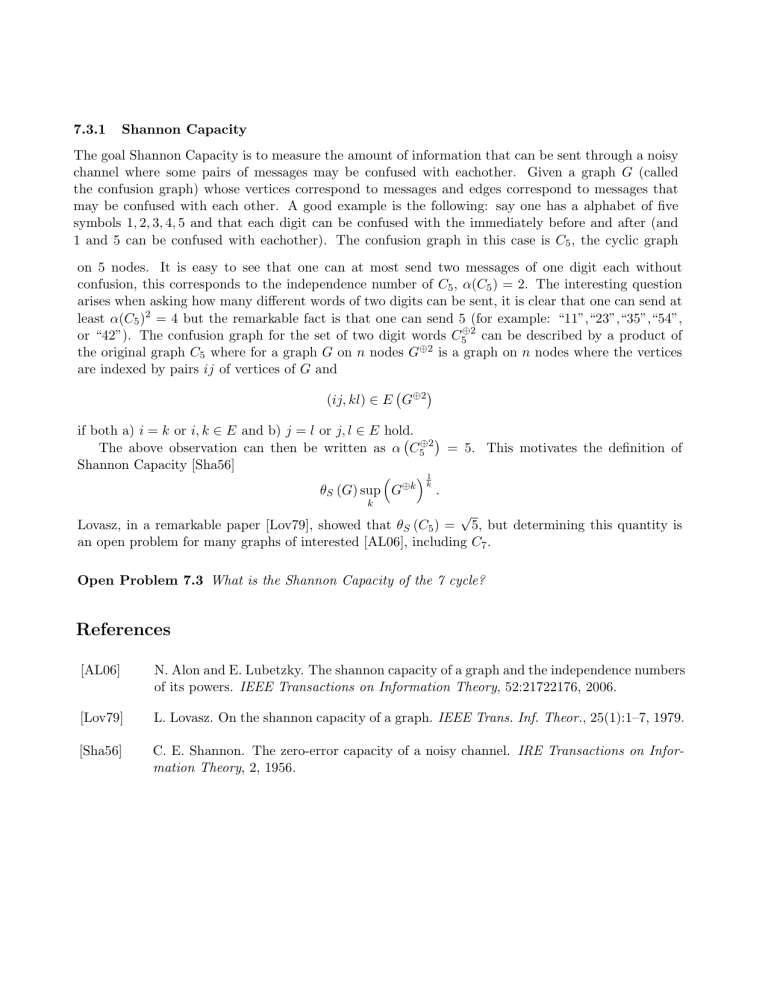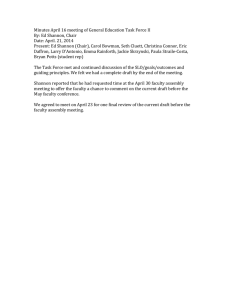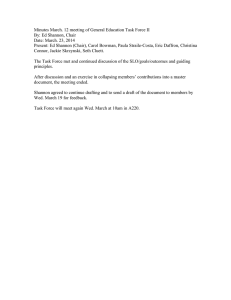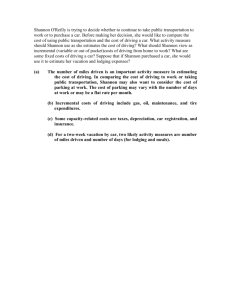7.3.1 Shannon Capacity

7.3.1
Shannon Capacity
The goal Shannon Capacity is to measure the amount of information that can be sent through a noisy channel where some pairs of messages may be confused with eachother. Given a graph G (called the confusion graph) whose vertices correspond to messages and edges correspond to messages that may be confused with each other. A good example is the following: say one has a alphabet of five symbols 1 , 2 , 3 , 4 , 5 and that each digit can be confused with the immediately before and after (and
1 and 5 can be confused with eachother). The confusion graph in this case is C
5
, the cyclic graph on 5 nodes. It is easy to see that one can at most send two messages of one digit each without confusion, this corresponds to the independence number of C
5
, α ( C
5
) = 2. The interesting question arises when asking how many different words of two digits can be sent, it is clear that one can send at least α ( C
5
)
2
= 4 but the remarkable fact is that one can send 5 (for example: “11”,“23”,“35”,“54”, or “42”). The confusion graph for the set of two digit words C
⊕ 2
5 can be described by a product of the original graph C
5 where for a graph G on n nodes G
⊕ 2 is a graph on n nodes where the vertices are indexed by pairs ij of vertices of G and
( ij, kl ) ∈ E G
⊕ 2 if both a) i = k or i, k ∈ E and b) j = l or j, l ∈ E hold.
The above observation can then be written as α C
⊕ 2
5
Shannon Capacity [Sha56]
1 k
θ
S
( G ) sup k
G
⊕ k
.
= 5. This motivates the definition of
Lovasz, in a remarkable paper [Lov79], showed that θ
S
( C
5
) =
√
5, but determining this quantity is an open problem for many graphs of interested [AL06], including C
7
.
Open Problem 7.3
What is the Shannon Capacity of the 7 cycle?
References
[AL06]
[Lov79]
[Sha56]
N. Alon and E. Lubetzky. The shannon capacity of a graph and the independence numbers of its powers.
IEEE Transactions on Information Theory , 52:21722176, 2006.
L. Lovasz. On the shannon capacity of a graph.
IEEE Trans. Inf. Theor.
, 25(1):1–7, 1979.
C. E. Shannon. The zero-error capacity of a noisy channel.
IRE Transactions on Information Theory , 2, 1956.
MIT OpenCourseWare http://ocw.mit.edu
18.S096 Topics in Mathematics of Data Science
Fall 20 1 5
For information about citing these materials or our Terms of Use, visit: http://ocw.mit.edu/terms .





